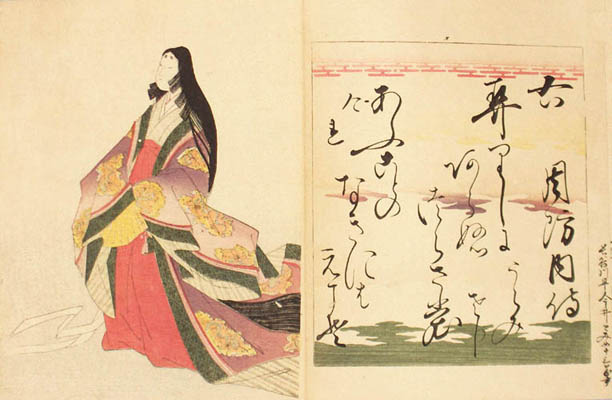
"The 36 Women Poets" illustrated by Eishi and Hokusai.
The album Nishikizuri onna sanjurokkasen known in the West by the shortened title "The Thirty-six Immortal Women Poets" is one of the most fascinating Japanese publications of the early 19th century lavishly printed in colour by woodblock.
It was published in 1801 by the Edo publisher Eijudo Nishimuraya Yohachi with thirty-six plates by Hosoda Eishi (1756-1829), one frontispiece plate by Katsushika Hokusai (1760-1849), one preface, two pages of after-words and a colophon.
Each plate depicts, on the left, one of the thirty-six women poets active during the Heian (794-1185) and Kamakura (1185-1333) periods and, on the right, one of their poems.
Their poems were an important element of classical culture from the 9th to the 12th century. The essence of their poetry related to court life and its refinement was imitated, in various artistic forms, in later centuries.
The portraits of these women poets show the two main qualities, common to the best Japanese prints: a refined palette of colours and the ornate design of the figures. The calligraphy, on the right part of each plate, is decorated with a pattern of coloured clouds. A fine composition, of line and colour, which shows each poetess with her poem.
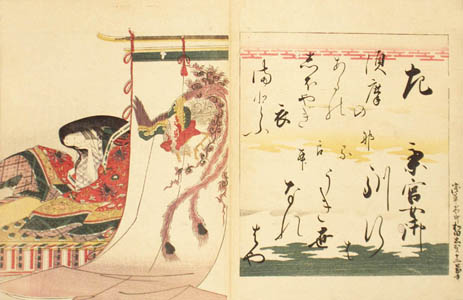
Hosoda Eishi, the author of the thirty-six portraits, was originally from a family of samurai. A famous painter and printmaker in the ukiyo-e style, he is celebrated for his tall female figures. His noble origin and early experience in the Kano school of painting were probably of some help in working on the classical theme of the album. The other artist collaborating in this album is Katsushika Hokusai. His involvement is limited to the illustration of the frontispiece. The plate depicts a group of noblemen, with their porters, walking along a country road, while three children are laughing as they pass.
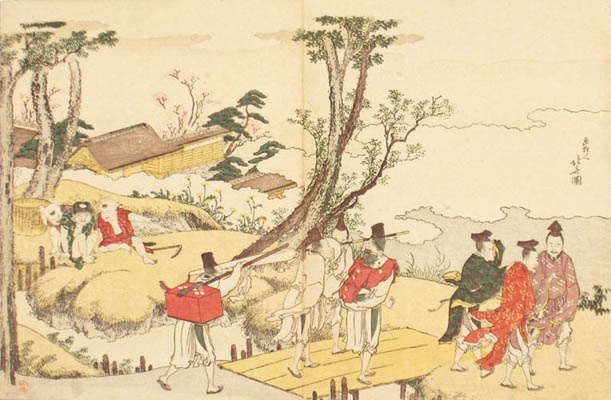
The meaning of this beautiful plate, is not clear and the light irony of Hokusai is far from the aristocratic theme of the book.
"The Thirty-six Immortal Women Poets" is a deluxe edition published at the request of Hanagata Yoshiakira, a calligraphy master. The purpose of the album was to promote his school. The ancient poems were, in fact, transcribed by his young female pupils whose name, address and age are recorded in the right-hand margin of each plate.
Copies of this album, sometimes lacking the pages of text, are in a few museums and private collections. The copy here presented and offered in our catalogue no. 8 is complete, and has an important and well-documented provenance which provides the opportunity to mention two leading figures in the early history of Japanese art collecting, Edmond de Goncourt (1822-1896) and the Japanese dealer Hayashi Tadamasa (1856-1906).
The album has four impressed seals by Hayashi and, on the last page of the preface a descriptive note in the hand of Edmond de Goncourt which ends with the words: Exemplaire de la plus grande beauté de cet ouvrage bien rarement precedé de sa preface et suivi de sa post-face. Exemplaire acheté 200 francs en 1888 chez Hayashi.
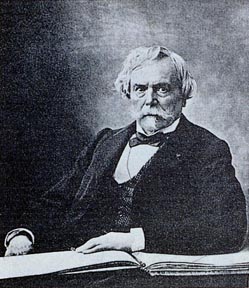
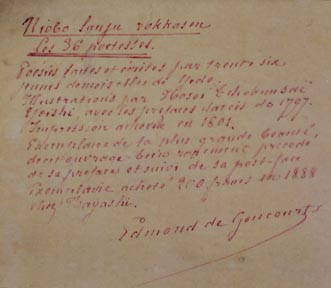
Edmond de Goncourt (1822-1896). The autograph note.
Edmond de Goncourt, and his younger brother Jules (1830-1870), were novelists, collectors and influential art critics. They were among the first to come in contact with Japanese art and to develop a special interest in graphic art. With their writing they played an important role in spreading the "Japanese craze" in France.
Whilst the de Goncourts were so important in the collecting world of their time, a fundamental role was also played by Hayashi Tadamasa who imported from Japan thousands of prints and objects d'art. Hayashi arrived in Paris in 1878, as interpreter and assistant to Wakai Kenzaburo (1834-1908), to attend the Exposition Universelle. After the Fair was concluded he started the antiquarian business with Wakai . When in 1886 Wakai retired, he continued independently and in a few years he became one of the most successful dealers in Paris.
He contributed greatly to the formation of the major collections of his day, and supplied the basic information for the first western publications on Japanese art, such as L'art Japonais by Louis Gonse and the monographs on Utamaro and Hokusai by Edmond de Goncourt. The Thirty-six Immortal Women Poets" was purchased, with another album by Utamaro, from Hayashi on the 7 May of 1888. This exact date is recorded by Edmond in his Journal, mémoires de la vie littéraire.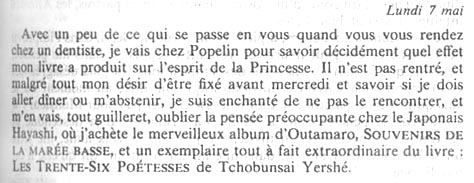
Eight years later Edmond died. His will ordered the sale of his collection at auction to give the opportunity to other collectors to acquire his treasures. The catalogue for the sale, held at the Hotel Drouot on 8-13 March 1897, was written by Siegfried Bing (1838-1905), also a famous dealer and collector of Japanese art. The album by Eishi was lot no.1499. The description mentioned the autograph note by de Goncourt in the preface with the price previously paid, but omits the provenance from Bing's Japanese competitor.
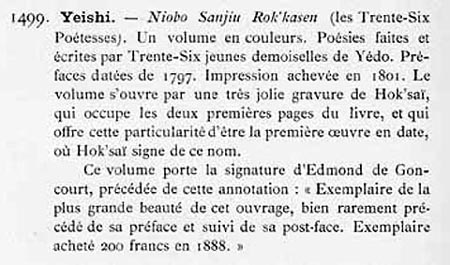
Hayashi was at that time still very active, and probably was also attending the auction as a buyer, with a view to re-acquiring many of the prints and objects he had sold years before.
Literature: Louise Norton Brown. Block Printing and Book Illustration in Japan. London: George Routledge & Sons Ltd. 1924, p. 172. Jack Hillier. The Art of the Japanese Book. London: Sotheby’s, 1987, p.454. The copy of Nishikizuri onna sanjurokkasen in the Spencer Collection, New York Public Library, has been reproduced in facsimile with a full translation and commentary in : Andrew J. Pekarik. The Thirty-six Immortal Women Poets. A poetry album with illustrations by Chobunsai Eishi. London: Barrie & Jenkins, 1991.
Designed & Written by Lella e Gianni Morra © 2002-Present (All Rights Reserved)
